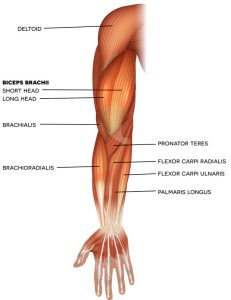The flexors of the wrist and fingers are used every time a dumbbell is curled, a treadmill bar is grasped, a smartphone is held and so much more. Of the dozens of muscles that orchestrate these movements, there are five muscles in the anterior forearm working together to facilitate wrist and finger flexion. Here is a breakdown of forearm flexor anatomy in a list and further down you can find them on yourself using this hands-on video.
 Flexor Carpi Radialis (FCR)
Flexor Carpi Radialis (FCR)
Palmaris Longus (PL)
Flexor Carpi Ulnaris (FCU)
Flexor Digitorum Superficialis (FDS)
Flexor Digitorum Profundus (FDP)
There’s a lot of words in each of these names, until we break them down. Carpi means wrist and digi means fingers. Flexor speaks for the action, ulnaris and radialis refer to the bones and then there’s just a few words left. Identifying where these muscles are enhances body awareness. When you know where these muscles attach you can exercise them more effectively, rest them when overtired and massage the muscle bellies for relaxation.
Where are the wrist and finger flexors located?
The wrist and finger flexors are located on the anterior forearm. They all originate on the medial side of the arm and insert out into the wrist and fingers. Supinating the forearm will bring them facing up so you can begin to explore.
Start by palpating the medial epicondyle of the humerus, this is where all of these muscles except for FDP attach. The medial epicondyle is located at the medial side of the elbow flexor crease. It protrudes out toward the body, whereas the lateral epicondyle of the forearm extensors protrudes out away from the body.
[sc name=”anatomy” ]
Here are the specific attachments:
Flexor Carpi Radialis – medial epicondyle to bases of 2nd & 3rd metacarpals
Palmaris Longus – medial epicondyle to flexor retinaculum & palmar aponeurosis
Flexor Carpi Ulnaris – medial epicondyle & posterior proximal 2/3 of ulna to pisiform, hook of hamate & base of 5th metacarpal
Flexor Digitorum Superficialis – medial epicondyle, ulnar collateral ligament, coronoid of ulna, interosseous membrane & proximal shaft of radius to sides of middle phalanges of 2-5 fingers
Flexor Digitorum Profundus – anterior & medial surfaces of proximal 3/4 of ulna to bases of distal phalanges, palmar surface of 2-5 fingers
Now, that’s a lot of nitty-gritty words right there. So, check out this video to get away from the lingo and into the actual forearm. Grab some washable markers before you hit play.
When you’re done coloring, snap a photo and post it in our anatomy group.
Forearm Flexor Exercises
As with all muscles, moving the attachments of a muscle closer to each other shortens the muscle. Add resistance and you will get a contraction. Any time the wrist is flexed by bringing the palm of the hand closer to the forearm these muscles are contracting. Even when the wrist is being held in neutral, as it is during bicep curls, you will be engaging the flexors.
The FDS and FDP attach out to the fingers, so they also work when the fingers are flexing. The palmaris contracts in actions such as grabbing a tennis ball, when the palm makes a cup shape. All of these muscles factor into grip strength.
Wrist Flexor Exercises:
Wrist curls
Bicep curls
Squeezing a tennis ball
How do you loosen short forearm muscles?
To stretch the flexors of the wrist and fingers, bring the attachment sites away from one another, into wrist extension (extend your arm and put your palm out as if to say “stop”). Be gentle with this stretch because there are nerves and vessels running through the carpal tunnel that can get squeezed too hard.
Hand and forearm massage is a great way to relax these muscles and enhance blood flow for recovery and repair as well. It’s one area of the body that a person can massage on their own fairly easily, which is why teaching a client where these muscles are is helpful. Encourage your clients to massage their forearms and hands in the evening before bed. It’s a great alternative to screen time before sleep and will help them reduce stress and relax.
Learning about muscles enhances the mind-body connection and expands understanding about the fascinating body we all get to live in. Happy exploring!
Beverly Hosford, MA teaches anatomy and body awareness using a skeleton named Andy, balloons, play-doh, ribbons, guided visualizations, and corrective exercises. She is an instructor, author, and a business coach for fitness professionals. Learn how to help your clients sleep better with in Bev's NFPT Sleep Coach Program and dive deeper into anatomy in her NFPT Fundamentals of Anatomy Course.

